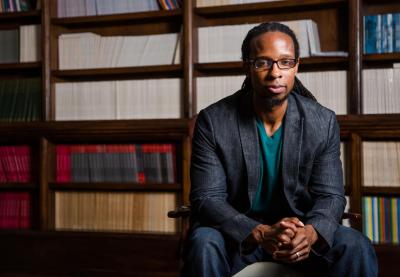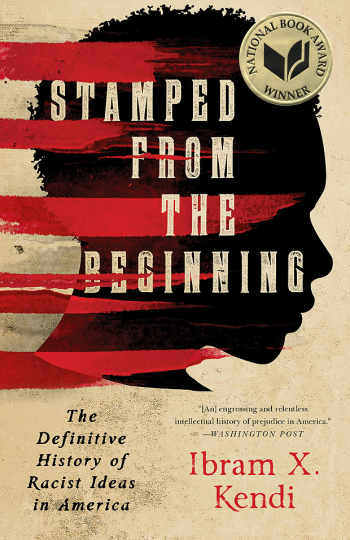Ibram Kendi’s Stamped from the Beginning: The Definitive History of Racist Ideas in America is a nearly 600-page history text. As three educators who work in three different university and P-16 settings, we know the constraints facing today’s teachers: There is scant time for reading at all, much less reading 600-page books. Could such a book be of use to educators in K–12 classrooms?
We are also founding members of a graduate student–led group called Teaching for Social Justice. Our group is deeply committed to fostering conversations about critical issues in education, including race, so we decided to dive in. Kendi’s book fed our group’s conversations for an entire summer while we worked our way through the text together, one illuminating section at a time.
After reaching the final page, our members answered the question, “Could this book be useful to educators in K–12 classrooms?” with a resounding “yes!” We were grateful for what we had learned and were curious to learn more. Fortunately, in addition to being educators, we attend the University of Florida where Kendi is an assistant professor of African-American history, so we reached out to him with our questions.
First things first: What made you suggest such a provocative title?
The main title comes from a speech that Jefferson Davis gave before the U.S. Senate on April 12, 1860, and ironically the book came out this year on April 12. In that speech, he was basically arguing against a bill that would have provided vocational funds to educate black children in Washington, D.C. He opposed the bill and stated that the American government was created by white men, for white men and that the inequality between the black and white races was “stamped from the beginning.” […] In American history, of course, Jefferson Davis goes on to become the president of the Confederacy, who in their cornerstone [held] that the natural condition of black people is slavery, and so really the cornerstone of his nation was a racist idea.
If you take it outside of the speech and just look at the words literally, the book chronicles the fact that racist ideas were stamped from the beginning of America. Racist ideas did not emerge in the 1800s like many people have thought. They actually came over to early, colonial America in the minds of some of the original settlers. Then the other side is that this book chronicles that racial discrimination was stamped from the beginning, and that racist ideas have long been used to rationalize and normalize the effects of racial discrimination, which are racial inequity and disparities.
The subtitle actually was … my publisher’s idea. I guess they were really excited about the book, but one of the reasons I was okay with it—because I’m pretty humble, and to call a book that nobody has reviewed “definitive” is pretty bold—let me put it this way: typically white scholars write definitive books. I think it was a statement in and of itself, an anti-racist statement in and of itself, that a black scholar can enter a field of the history of racist ideas primarily dominated by white scholars and declare that his book is definitive. I think in and of itself it was sort of a political statement.
With a powerful message like that, whom did you have in mind as the intended audience for this book?
My intended audience is anyone and everyone who is interested in racial issues and social justice issues in American history—not just academics. My intended audience is anyone trying to make sense of all of the black lives that are being lost to police violence and the series of other calamities that people experience.
I wanted the book to be as accessible as possible for as many people as possible while simultaneously maintaining its complex nature, because the history of racist ideas is extremely complex. [T]he book could have easily been 2,000 pages, but I felt it was my job as a writer to communicate the complexities of racist ideas and simplify those complexities for readers.
What other messages do you hope teachers, especially teachers of young children, take away from your work?
I think one takeaway … would be that there are many educators who are very, very passionate about eliminating what’s called the “academic achievement gap” and providing opportunities for what they consider to be improving the literacy of black children in poor schools. Their perception is that if only these kids had the opportunity and had better schools, and if their schools only had more money, then they would be achieving at the same level as the white kids in richer schools.
Part of what is difficult for a teacher to even imagine is that black kids could be intellectually on the same level as kids in the rich schools, but if we really start to think about it, we have to acknowledge that the achievement gap is based on … whether or not kids know how to take a standardized test. So really, that, as a measurement for achievement, needs to be thrown out. Then if we throw those out, then we begin to vocalize and individualize what achievement looks like and give the power back to the teachers to dictate what achievement is for each child, each classroom, and each community as opposed to creating this massive hierarchy that we have now.
The anti-racist position would state that the way these black kids show their intelligence is not inferior, but it’s different. It’s the job of the teacher to nurture that difference as opposed to trying to civilize them to so-called norms. Teachers are literally teaching ideas, even teaching students culture. If they themselves harbor racist ideas, then those racist ideas are going to come out in their teaching.
It’s very complex, and yet some anti-racist ideas are simple, basic. Different doesn’t necessarily mean inferior. I think that idea can be taught to younger children. I also think teaching young kids not to generalize individuals, not to say that this group does that because that one individual does it, is extremely important. That’s another regular racist idea: When an individual black person does something negative and people generalize and say, “That’s just the way black people act.” Children, of course, consume racist ideas. They consume ideas about darker skin being uglier than lighter skin. They consume ideas like that particular neighborhoods are more dangerous or safer than others. They consume ideas that white people are smarter. They consume ideas connecting blackness to violence, so that creates a difficult situation for teachers who have an anti-racist position.
How might educators convince their students of the value of learning the history of racist ideas?
I think first and foremost we need to recognize that this is bigger than history. This is people’s sense of themselves, and that’s why it’s so difficult for them to think differently and be differently.
There are just some [educators] who don’t value … social sciences in general. In their minds their objective is to get a job or to get their students a job, so they won’t really recognize the value of humanities. What I would say in terms of those people who make that case and who don’t understand that value is, “What is your purpose in life? Do you have a purpose? Are you happy? Do you [want] your students to be happy?” Typically, people say yes. Studies show that, of course, there’s no correlation between money and happiness. There is a correlation between knowledge and relationships and happiness. People’s ability to form close relationships with other people is actually the best predictor of a person’s happiness. How does a person become the type of person other people want to be close to? I think the humanities, studying what it means to be human, is an important exercise for that goal.
History is a mechanism for allowing people to understand their current conditions and to have an idea of what those conditions might be tomorrow. History is vitally important.
Keeping the Conversation Going
Kendi is steadfast in his belief that “If there was ever a person in our society who must be an intellectual, it’s an educator.” Creating equitable and just schools requires a nuanced understanding of our contemporary school system’s inception, and Stamped from the Beginning’s rich and detailed narrative illuminates the historical realities that shape the current educational landscape.
“I’m most pessimistic when I can’t envision a future and a way to move forward,” Kendi noted during our interview. But the tremendous effort he put into this book did not leave him pessimistic. Despite his exhaustive review of the troubling history of racist ideas, Kendi maintains a refreshing, persistent hope. Readers will be pleasantly surprised by the optimistic tone of the epilogue, in which he encourages educators to press on with their social justice aims.
In our conversation with Dr. Kendi, he shared that one of his goals is to start a dialogue about how we might “create a different America where we can put race behind us.” An avid blogger and Twitter user, Kendi has already initiated this dialogue and is “looking forward to engaging educators with this work,” whether through formal professional development mechanisms or individual, grassroots initiatives for teacher learning and change. We encourage you to follow his work online, join the conversation and consider reading Stamped from the Beginning.


